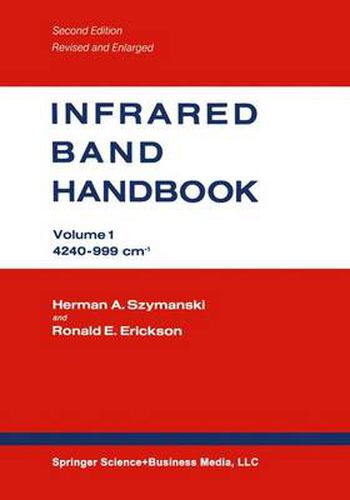Readings Newsletter
Become a Readings Member to make your shopping experience even easier.
Sign in or sign up for free!
You’re not far away from qualifying for FREE standard shipping within Australia
You’ve qualified for FREE standard shipping within Australia
The cart is loading…






This Handbook includes all the data of the first edition and its supple ments and sufficient additional material to nearly double the total number of entries. It is hoped that enough entries are now given to represent most structural groups and environments. Infrared spectroscopy as a tool for the identification of compounds can be used in conjunction with other methods, such as NMR and UV spectros copy, or alone to quickly establish the presence or absence of particular structural groups. Computer search techniques can be applied to infrared data for the identification of unknowns, but the time required for the analysis will be substantial. These volumes will best serve those who wish to locate infrared data quickly and without recourse to instruments or related equipment. Typical applications in which the Handbook can best be utilized follow. 1. Searching a specific wavelength region for samples of compounds having absorption bands in that region, and relating this information to the compound under study. 2. Assigning vibrations for a compound by noting assignments for similar compounds. 3. Obtaining literature references. 4. Obtaining optimum sample conditions for determining the spectrum of a compound. 5. Identifying an unknown where data are not readily available. 6. Locating literature data on band positions, including references where only one band position is reported. 7. Enlarging present data files, including computer tapes. 8. Browsing through as many data as one wishes. Other mechanical or computer sources often yield too many data.
$9.00 standard shipping within Australia
FREE standard shipping within Australia for orders over $100.00
Express & International shipping calculated at checkout
This Handbook includes all the data of the first edition and its supple ments and sufficient additional material to nearly double the total number of entries. It is hoped that enough entries are now given to represent most structural groups and environments. Infrared spectroscopy as a tool for the identification of compounds can be used in conjunction with other methods, such as NMR and UV spectros copy, or alone to quickly establish the presence or absence of particular structural groups. Computer search techniques can be applied to infrared data for the identification of unknowns, but the time required for the analysis will be substantial. These volumes will best serve those who wish to locate infrared data quickly and without recourse to instruments or related equipment. Typical applications in which the Handbook can best be utilized follow. 1. Searching a specific wavelength region for samples of compounds having absorption bands in that region, and relating this information to the compound under study. 2. Assigning vibrations for a compound by noting assignments for similar compounds. 3. Obtaining literature references. 4. Obtaining optimum sample conditions for determining the spectrum of a compound. 5. Identifying an unknown where data are not readily available. 6. Locating literature data on band positions, including references where only one band position is reported. 7. Enlarging present data files, including computer tapes. 8. Browsing through as many data as one wishes. Other mechanical or computer sources often yield too many data.